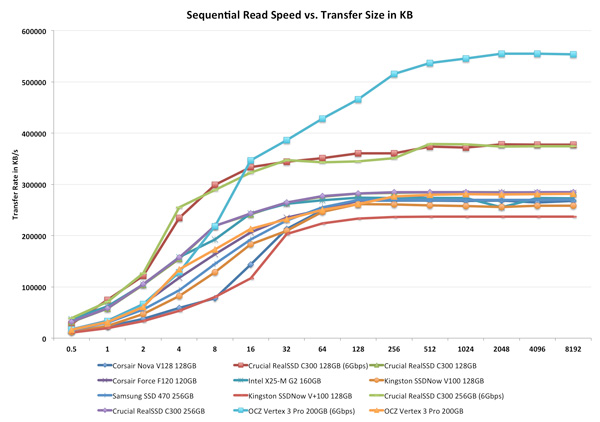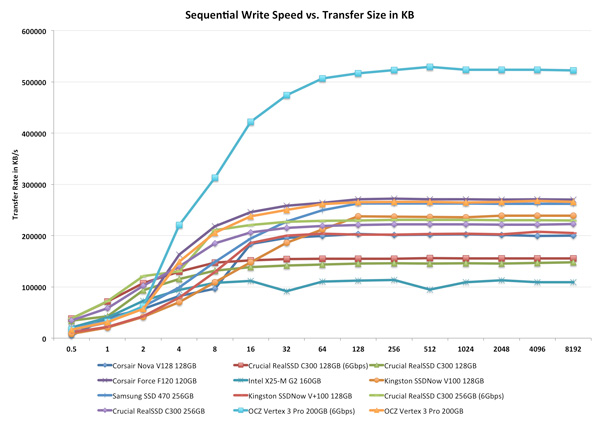OCZ Vertex 3 Pro Preview: The First SF-2500 SSD
by Anand Lal Shimpi on February 17, 2011 3:01 AM ESTPerformance vs. Transfer Size
All of our Iometer sequential tests happen at a queue depth of 1, which is indicative of a light desktop workload. It isn't too far fetched to see much higher queue depths on the desktop. The performance of these SSDs also greatly varies based on the size of the transfer. For this next test we turn to ATTO and run a sequential write over a 2GB span of LBAs at a queue depth of 4 and varying the size of the transfers.
On a 6Gbps SATA port the Vertex 3 Pro is unstoppable. For transfer sizes below 16KB it's actually a bit average, and definitely slower than the RealSSD C300. But once you hit 16KB and above, the performance is earth shattering. The gap at 128KB isn't even as big as it gets, we don't see leveling off of performance until 2048KB transfers.
The 3Gbps performance is pretty unimpressive. In fact, the Vertex 3 Pro actually comes in a bit slower than the SF-1200 based Corsair Force F120. If you're going to get the most out of this drive you had better have a good 6Gbps controller.
ATTO's writes are fully compressible, indicative of the sort of performance you'd get on applications/libraries/user data and not highly compressed multimedia files. Here the advantage is just hilarious. By the 8KB mark the Vertex 3 Pro is already faster than everything else, but by 128KB the gap is more of a chasm separating the 6Gbps Vertex 3 Pro from its competitors.
Over a 3Gbps interface the Vertex 3 Pro once again does well but still doesn't really differentiate itself from the SF-1200 based Force F120. Real world performance is probably a bit higher as most transfers aren't perfectly compressible, but again if you don't have a good 6Gbps interface (think Intel 6-series or AMD 8-series) then you probably should wait and upgrade your motherboard first.












144 Comments
View All Comments
Slimline - Thursday, February 17, 2011 - link
This sounds interestingTrefugl - Thursday, February 17, 2011 - link
Indeed. I'm particularly liking the conclusion:'We're still a couple months away from knowing exactly what to buy, but if you've been putting off that move to an SSD - 2011 may be the year to finally pull the trigger"
That pretty much describes me perfectly. I do have an SSD in my work's workstation, but for home, but I've been holding out for 2011 (IMFT 25nm NAND) and I'm thinking I might not be disappointed by the wait.
Drag0nFire - Friday, February 18, 2011 - link
Indeed. I'm particularly excited to see what will happen when Intel shows up to the fight.MeanBruce - Friday, February 18, 2011 - link
Intel announced their 510 SSD G3 series today, it will come in 120Gb and 250Gb capacities, SATA3 6Gb/s, read/writes of 470Mb/s and 315Mb/s respect, and will be priced at $280 and $580! It's not using an Intel controller word is Intel doesn't have an in house controller with any real speed! SandForce is really shakin' things up! ;)MrBrownSound - Friday, February 18, 2011 - link
woah, no kidding. I'm looking forward to any reviews of it.MeanBruce - Saturday, February 19, 2011 - link
I knew when Intel pulled their G3 SSD lineup by rescheduling the release it had nothing to do with time constraints and everything to do with the numbers released shortly after by OCZ about their new SandForce controllers, 500/500 read/writes had Intel drawing up an entirely new gameplan for the new G3 lineup! But honestly I thought they would just let a little more magic out of the bag, I had no idea their bag was empty! Now I found out the new 510 series that becomes available March 1st is just going to use a Marvell controller just like the new Crucial and Corsair drives. I still love my X-25M but it's sad when a company with that many resources kicks back on their laurels. Oh well the good news is SandForce is here and with their new client Seagate we will have lots of choices and overall it's just great for the industry at large! Just sucks to watch the one time leader down so low!Out of Box Experience - Saturday, February 19, 2011 - link
Over 50% of the boxes on the Planet still run XPSo, the big question is...
Which one is XP compatible Out of the Box?
I'd love to buy a Sata 3 SSD that can saturate my XP Sata 2 ports but should we stick with Older/Slower Intel Sata 2 SSD's for compatibility??????
Any comment on this issue?
anactoraaron - Monday, February 21, 2011 - link
I know everyone has their own reason for keeping XP... but if you want to buy a $200+ SSD how can you not pony up the 100 for windows 7?Besides, 2 more years until XP is officially obsolete...
Out of Box Experience - Monday, February 21, 2011 - link
Bla bla blaHaving Windows 7 does not mean we all need to throw out our XP Licences and all our software that does not run on 7
Why can't somebody just answer my question instead of changing the subject
We get it! You love all the spyware and DRM built into Windows 7 but others don't
So lets just stick to the question I asked shall we?
Which Sata 3 SSDs will be Alignment agnostic at the very least so they can be used on ANY O.S. besides Spyware 7?
bennyg - Monday, February 21, 2011 - link
Bla bla bla spyware bla drm bla blaYou forgot to mention how locking DX10 to Vista/7 was a deliberate ploy to force gameplayers to upgrade.
And how Win7 is just Vista done right.
Far out some people hold grudges. I was ambivalent about Win7 when it was forced upon me - but for multicore + SSDs you just can't consider an old OS that wasn't designed when they were on the radar.